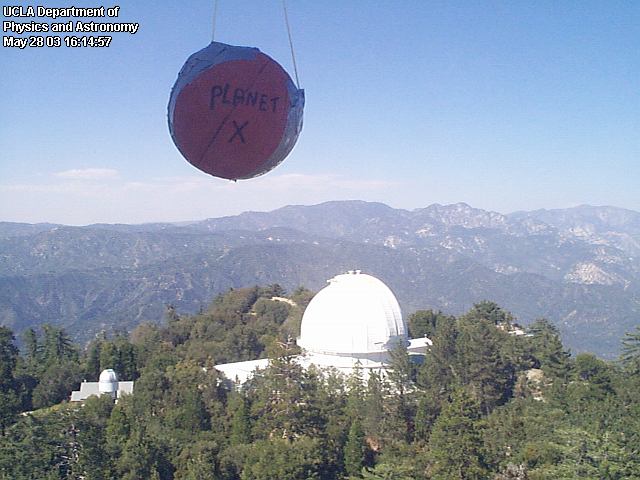If this non existent planet was real im afraid it would have been highly visible a long time ago. Guess what it isnt because it doesnt exist.
Meanwhile the fear diarrhea goes on no doubt...
If you are reading this at home kids dont worry..you are not going to be killed by a non existent planet so keep saving that pocket money
cut and paste job I know but its all you need to know
The planet "Nibiru" has a unique place in the constellation of 2012 claims. It's never been detected, cannot exist, and even if it was real (according to its promoter) isn't actually supposed to arrive until decades or even centuries after 2012. However, it's a very popular subject among both debunkers and proponents alike.
Zecharia Sitchin
The fictional planet called ‘Nibiru’ was proposed by a self-taught scholar of Sumerian cuneiform named Zecharia Sitchin. In the book The Twelfth Planet (1976) Sitchin used an image from a particular Sumerian seal, along with his own translation of Sumerian cuneiform, to argue that the Sumerians knew of 12 planets in the solar system, that the 12th planet is Nibiru, that it orbits the sun once every 3,600 years, that beings (that the Sumerians called ‘gods’) live on it, that these beings arrived on Earth some 450,000 years ago, that they created humans by genetic engineering of female apes, and that basically we were their slaves, digging up their gold for them.
No, really. That’s his claim.1
Jason Colavito says of Sitchin: "… Sitchin has claimed that the Anunnaki genetically engineered humanity, that the space invaders tried to destroy humanity in a flood, and that someday the aliens will return and bring a Biblical-style judgment on mankind."2
Poor scholarship
Sitchin leans heavily on translations of ancient texts, in particular his translations of ancient texts, which do not match the translations of other, more verified scholars. The SKeptic's DIctionary says of Sitchin:
Sitchin, like Velikovsky, presents himself as erudite and scholarly in a number of books, including The Twelfth Planet (1976) and The Cosmic Code (1998). Both Sitchin and Velikovsky write very knowledgeably of ancient myths and both are nearly scientifically illiterate. Like von Däniken and Velikovsky, Sitchin weaves a compelling and entertaining story out of facts, misrepresentations, fictions, speculations, misquotes, and mistranslations.3
In addition Sitchin ignores a vast body of research conducted by others, apparently because it conflicts with his interpretations. The examples are plentiful within The Twelfth Planet. For example, Hafernik points out:
Now we come to the word "shem". Much of Sitchin's interpretation revolves around the interpretation of this particular Biblical word. Interestingly, Kramer also looks into the meaning of the word "shem", but comes up with a study by a guy named Arno Poebel that describes a completely different alternate meaning from the one Sitchin promotes.
From "traditional" authorities, we see that shem is generally translated to mean "name", as it would be used in the sentence: Sam has made a name for himself. In this sense, it perhaps comes closer to "reputation" than the way we use the word "name" in modern English. Originally, it may also have meant "monument", a physical artifact that bore the name of something to be remembered.
All three of the translations of the Bible I checked (representing the reputations of hundreds of Biblical scholars) translate "shem" as "name". Asimov and Kramer go along with the rest. Sitchin argues that shem meant "monument", but that the monuments were copies of the rockets used by the ancient gods (space aliens).4
Poor translations
Sitchin has a habit of deciding what an ancient word really means in his personal, unique translation and then proceeding as if this is the end of the story, that nobody else's translations are more accurate, or that that other interpretations even exist. Many of his claims regarding the translation of Sumerian cuneiform are discussed in detail and debunked by Michael Heiser. In particular, one quote from Heiser jumps out:
In the texts that follow, Nibiru was regarded as a planet (specifically, Jupiter, but once as Mercury), a god (specifically, Marduk), and a star (distinguished from Jupiter).
If you’re confused, you aren’t alone. This tri-fold (fourfold if you count Mercury) designation for Nibiru is why scholars of cuneiform astronomy have not been able to determine with certainty what exactly Nibiru is. We’ll go into the problem more in later sections. One thing is certain from the texts, though: Nibiru is NEVER identified as a planet beyond Pluto.5
Poor science
Rob Hafernik is an aerospace engineer who worked on the NASA Shuttle program and has a page which completely debunks Sitchin’s 12th planet claims. On that page, Hafernik lays out the following summary of Sitchin's very odd ideas about the origins of the solar system:
Here's what he claimed happened (the numbering of the steps is my own, to make things easier to refer to later):
1) We started out with a solar system just like the one we have now, but the Earth and Moon are missing and there was a planet between Jupiter and Mars.
2) The planet Marduk arrived from outer space and passed near to Neptune. Marduk is a retrograde planet, orbiting in the opposite direction of all the others. Neptune's gravity bent its orbit so that it plunged down into the solar system (still against the grain, retrograde). At the same time, Neptune's gravity pulled a bulge in the side of Marduk (which was still plastic at this stage, it had just been formed).
3) The planet Marduk passed Uranus, where the bulge ripped open and several moons were pulled out of Marduk to orbit it. It's path was bent even more inward. As it pulled on Gaga, a moon of Saturn, Gaga was pulled loose and eventually became Pluto in its present day orbit.
4) Marduk approached Tiamat (the planet where the asteroid belt is now) and its gravity began to tear away bits of Tiamat.
5) Marduk missed hitting Tiamat, but its orbiting satellites delivered a mighty blow. They also exchanged lightening in the form of static electricity. Tiamat was cracked, but still together.
6) Marduk sailed out into deep space again, past Neptune.
7) When it came around again, Marduk smashed Tiamat all to hell. Half of Tiamat was destroyed and became the asteroid belt, the other half was hit sideways by one of Marduk's orbiting moons, knocked into the orbit of Earth and became the Earth. Kingu, one of Tiamat's satellites, went along with the broken half and became the Moon.

Marduk continues in this orbit today, swinging out past Neptune and back into the Asteroid belt in a retrograde orbit that takes 3,600 years to complete.6
Another set of pages debunking Sitchin’s claims is a series by Ian Lawton entitled “The Mesopotamia Papers“.
Nibiru not predicted for 2012
Here’s the big clincher; Sitchin’s original prediction of the appearance of Nibiru does not coincide with the 2012 date! According to Sitchin, Nibiru is not due to return until 2900! (Though he did say that the Annunaki might return by spaceship when the Age of Pisces moved to the Age of Aquarius sometime after 2090). So Sitchin doesn’t agree with the 2012ers! ( Or at least he didn’t until he started making money off of it; in the months leading to his death in 2010, he went somewhat quiet on the subject).
Nibiru's impossible orbit
Nibiru's proposed orbit would be highly elliptical. So highly elliptical that it is for all intents and purposes a straight line, out and back. We know this because a simple mathematical relationship exists between the period and the length of the semi-major axis of the ellipse.7
Kepler's Laws
German mathematician and astronomer Johannes Kepler (1571–1630) discovered three laws of planetary motion. They are:
"The orbit of every planet is an ellipse with the sun at a focus."
"A line joining a planet and the sun sweeps out equal areas during equal intervals of time."
"The square of the orbital period of a planet is directly proportional to the cube of the semi-major axis of its orbit."
Kepler's Laws applied to Nibiru
Since all planets orbit in ellipses with the Sun at one focus, Nibiru must go around the Sun, not just through the orbital paths of the planets.8
All planets sweep out equal areas in equal time intervals, so Nibiru must move very slowly at it's aphelion, or furthest point from the Sun, and very fast at it's perihelion, or closest point.9
The square of the orbital period of a planet is directly proportional to the cube of the semi-major axis of its orbit. Since Nibiru's period is specified as 3,600 years, we can use Kepler's third law to determine something about its orbit.10
Kepler's third law can be expressed as:
(1)
a3=p2
where a is the length of the semi-major axis in astronomical units (AU) and p is the period, in years. Applying a little middle-school algebra to this, we get:
(2)
a=(p2)−−−√3
So, assuming that perihelion is at or near Earth's orbit (since it is supposed to come close to us, or even hit us), the distance d from the sun at aphelion is going to be 2a−1 (twice the semi-major axis, minus 1 AU). Adding this to our formula gives us:
(3)
d=2((p2)−−−√3)−1
Substituting our period (3600 years) gives us:
(4)
d=2((36002)−−−−−−√3)−1
(5)
d=2(12960000−−−−−−−√3)−1
(6)
d=2(234.892058)−1
(7)
d=469.784116−1
(

d=468.784116
In other words, given a 3,600 year orbit that brings it to within 1 AU of the sun (the area of Earth's orbit) the far end of the orbit must be 469 AU out from the sun.
Just as a comparison point, Pluto is on average about 39.5 AU away from the Sun. It's year is about 248 earth years long. If we plug 248 into equation (2) above, we get 39.47 AU. We can see that the formula works.
Pluto's orbit is considered "highly elliptical". But it's not nearly as elliptical as the orbit proposed for Nibiru. Dr. Douglas Hamilton's 2D Orbital Elements calculator (after some trial and error) produces an orbit with an eccentricity of 0.995744. This produces an orbit with an approximate Perihelion distance of 1 AU, and a semi-major axis of 235. This is extremely eccentric.
Nibiru's impossible orbit
Image Unavailable
A screengrab of the output of Dr. Hamilton's 2D Orbital Elements calculator
At nearly 470 AU, the gravity of the sun is negligible, almost non-existent. So as a result, Nibiru must be traveling close to the Sun's escape velocity when it comes within 1 AU of it. At a distance of 1 AU, the Sun's escape velocity is about 42km/s, so this is the speed at which Nibiru should be traveling (or a hair under it) in 2012. In comparison, the Earth's orbital velocity is a bit under 30km/s, Venus' is about 35km/s and Mercury's is 47.8. Nibiru would be whipping around the Sun nearly as quickly as Mercury.
Unstable Orbit
The orbit described above would be highly unstable. A highly elliptical orbit is unstable because it will suffer drastically from the slightest perturbation - Jupiter's gravity would probably be enough to send Nibiru spiraling off to who knows where. Pluto's orbit is stabilized by Neptune, as Pluto is locked into a 2:3 orbital resonance with Neptune. The maths behind multiple body problems are nightmarish to sort out because they have no closed solutions (the objects all affect each other to such a degree that the orbits gradually precess), so professional astronomers use computers to perform these calculations. But you should understand this: As much as the fictional Nibiru would pull on other planets, those planets would also pull on Nibiru. With a long, thin ellipse as described, even the slightest nudge from the gravity of another object, even if that object is considerably smaller than Nibiru, would have a dramatic effect on Nibiru's orbit.11
Nibiru undetected
In the last few years, the news has been full of new planets discovered around other stars. Usually these are discovered by the observed light curve from the star where the planet partially eclipses the star, or by the motion of the star as the planet causes it to wobble. Very recently we actually visually detected a planet orbiting Fomalhaut. We can see distant objects in our own solar system which would be much dimmer than Nibiru. Remember that Nibiru is large, supposedly earth-sized or larger. Some claim that it is in orbit around a 'dark star', which would be even larger.
Even though we can detect sub-stellar objects, and now, even planets around other stars, why can't we find Nibiru?
Some have even suggested that it is invisible! Really? There is a quote for that:
"The invisible and the non-existent look very much alike." — Delos McKown
Nibiru should be Visible!
2012hoax contributor bikenbeer2000bikenbeer2000 has supplied us with the following table, calculated using the astronomy software suite StarryNight.
Here are the results of my Starry Night simulation of 'Nibiru'. This assumes an orbital period of 3,600 years and I have tweaked the perihelion distance to 0.984 AU (the same as the Earth's distance from the Sun on 21st December 2012) to ensure that it comes pretty close to us. The magnitude assumes an Earth-sized object. Corrections may be made to suit various crackpot predictions, as required. For example, for an object 4 times the diameter of the Earth, subtract 3.0 from the magnitudes. For a Jupiter-sized object, subtract 5.0.
Date Distance from Sun (AU) Magnitude
2010 Jul 01 9.36 5.5
2010 Oct 01 8.66 5.3
2011 Jan 01 7.94 5.2
2011 Apr 01 7.20 4.8
2011 Jul 01 6.43 3.8
2011 Oct 01 5.60 3.2
2012 Jan 01 4.72 3.1
2012 Apr 01 3.78 2.2
2012 Jul 01 2.76 0.2
2012 Oct 01 1.65 -3.8
2012 Dec 21 0.98 -17.9
So as of August 2010, if Nibiru were the size of the Earth, it should be at least 5.5 Magnitude, visible as a dim star to the naked eye, but easily visible in a telescope. In fact, that is about the same magnitude of Uranus in August 2010. If it were 4 times the size of the Earth, it would be a magnitude 2.5, and if it were as big as Jupiter, it would be a 0.5, larger and brighter than Saturn, which is easily viewable in the Western sky just after sunset.
Fraudulent "Nibiru" videos on YouTube
Since "Nibiru" is so easily debunked, we're surprised that anyone would make fraudulent videos claiming to show it. Nevertheless, such videos are indeed made, and apparently have a large viewership on YouTube. We've spent considerable time refuting those videos in our forums. We'll describe a few examples.
Faked images are common, as explained at length on our YouTube page. More insidious are cases where the perpetrator presents real footage he has taken of objects such as planets, but lies about the objects' identities. One of our members, bikenbeer2000bikenbeer2000, caught YouTuber jcattera in this type of fraud. Bikenbeer's analysis is illustrated in this post. (Actually, jcattera referred to the object as "Planet X", or the "Brown Dwarf", rather than "Nibiru", but he seems to use all three terms virtually interchangeably.)
For more about common techniques of making fraudulent (or honestly mistaken) "Nibiru" videos, please see our YouTube page.
Conclusion
In conclusion: We have shown that Zecharia Sitchin is not a scholar of Sumerian cuneiform. He ignores a rich body of scholarship and develops his own unique and unsupported translations, mixing freely between languages as he sees fit. Serious scholars of Sumerian texts have challenged his work on issues of poor translations, poor scholarship, and special pleading. Sitchin's concept of Nibiru is not supported by the texts that he uses as the basis for his claims.
Sitchin's claims run counter to much that we know and understand about our solar system. There are fundamental flaws with Sitchin's claimed orbit for Nibiru, including the claim of its period and the position of its perihelion. Sitchin's claims for Nibiru's orbit are impossible: The claimed orbit would be highly unstable, and Nibiru would have been ejected from the solar system by the gravity of the gas giants long ago. When confronted with the lack of visual evidence, the proponents of Nibiru rely on special pleading (e.g., that Nibiru is invisible, unlit or hidden).
Further Reading
http://www.2012hoax.org/nibiru




















